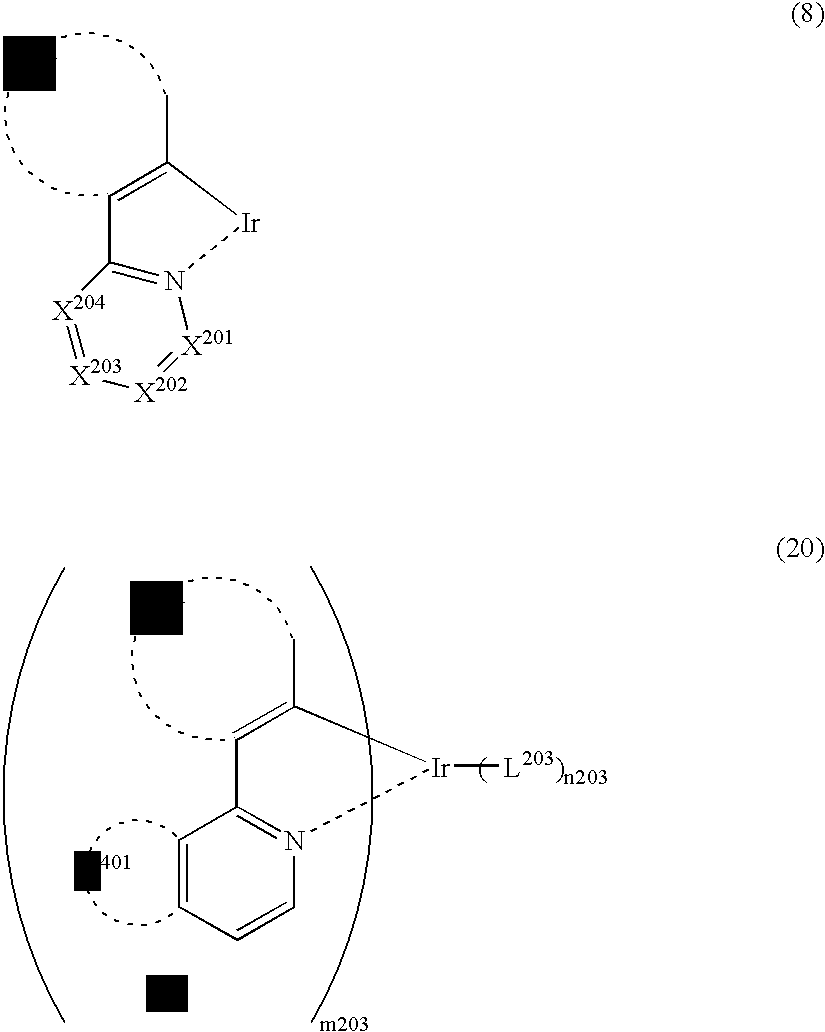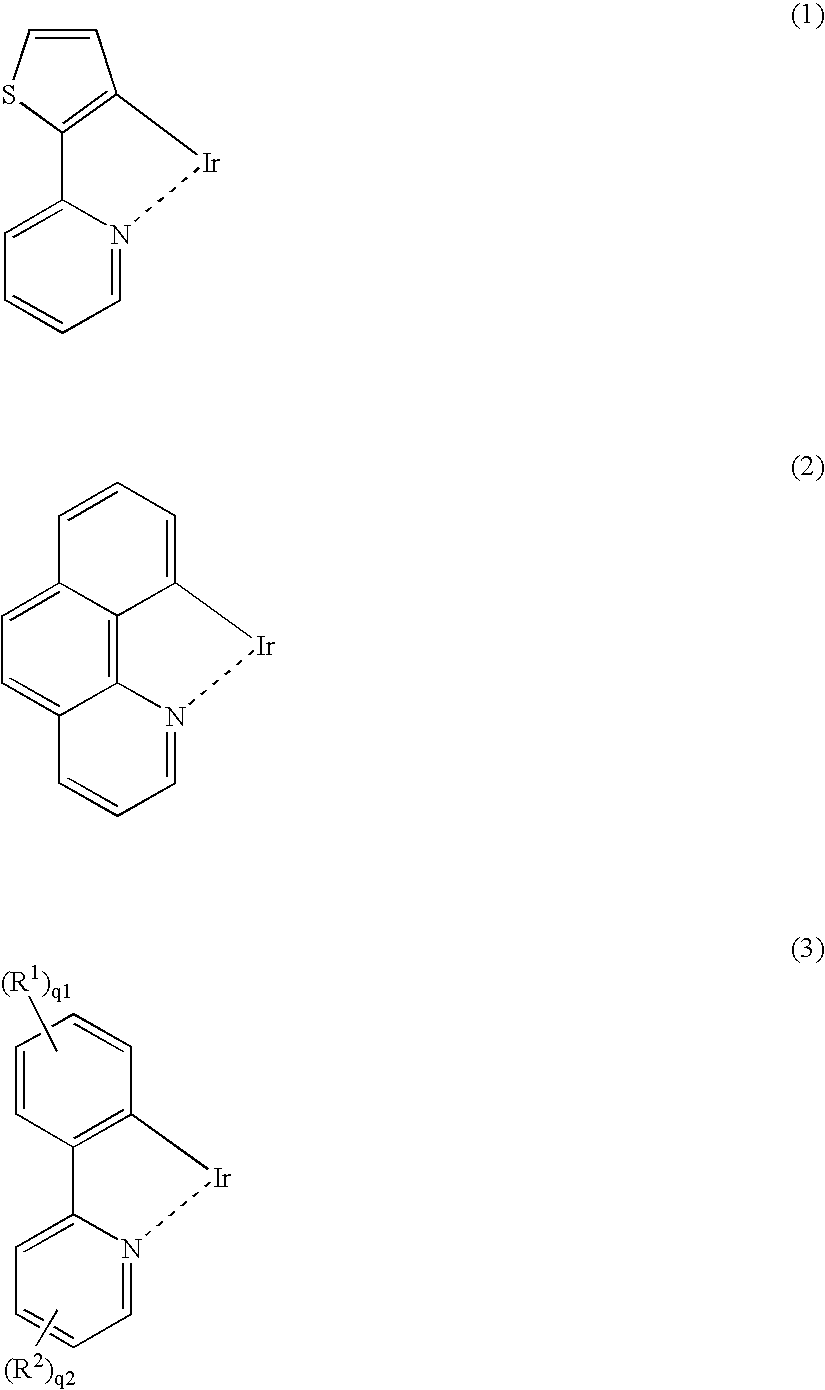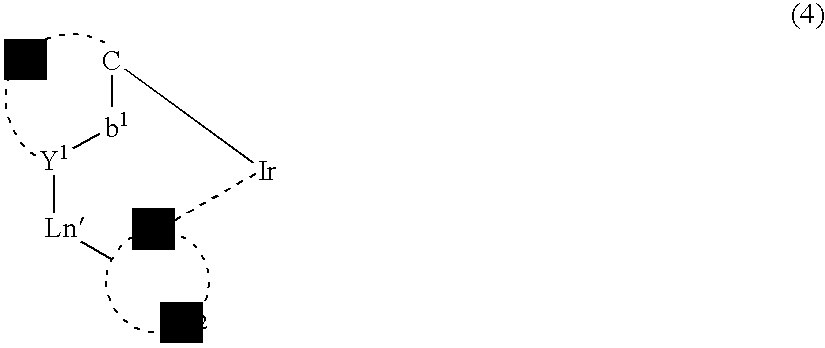Light-emitting material comprising orthometalated iridium complex, light-emitting device, high efficiency red light-emitting device, and novel iridium complex
a technology of orthometalated iridium complex and light-emitting device, which is applied in the direction of group 3/13 element organic compounds, group 5/15 element organic compounds, etc., can solve the problems of narrow range within which to apply as a display, and the device prepared by the conventional coating method is inferior to that prepared by vacuum evaporation method in light-emitting efficiency
- Summary
- Abstract
- Description
- Claims
- Application Information
AI Technical Summary
Benefits of technology
Problems solved by technology
Method used
Image
Examples
synthesis example 1
Synthesis of Exemplary Compound (1-25)
[0089]Into a three neck distillation flask were charged 5.22 g of K3IrCl6, 16.9 g of 2-benzylpyridine and 50 ml of glycerol. The contents of the flask were then heated to an internal temperature of 200° C. with stirring in an argon atmosphere for 1 hour. Thereafter, the contents of the flask were cooled to an internal temperature of 40° C. To the material was then added 150 m1 of methanol. The material was further stirred for 1 hour, and then subjected to filtration with suction to obtain a crystal which was then purified through silica gel column chromatography to obtain 4.34 g of the desired exemplary compound (1-25) (yield: 77%).
synthesis example 2
Synthesis of Exemplary Compound (1-24)
[0090]Into a three neck distillation flask were charged 5.64 g of the exemplary compound (1-25), 560 ml of chloroform and 10.0 g of acetylacetone. To the contents was then added dropwise 20.1 ml of a 28% methanol solution of sodium methylate at room temperature with stirring in 20 minutes. After the termination of dropwise addition, the mixture was then stirred at room temperature for 5 hours. The mixture was then extracted with 40 ml of saturated brine and 400 ml of water. The resulting chloroform phase was washed with a mixture of 300 ml of saturated brine and 30 ml of water four times, dried over anhydrous sodium sulfate, and then concentrated through a rotary evaporator. The resulting residue was then purified through silica gel column chromatography to obtain 5.59 g of the desired exemplary compound (1-24) (yield: 89%).
synthesis example 3
Synthesis of Exemplary Compound (1-26)
[0091]Into a three neck distillation flask were charged 6.28 g of the exemplary compound (1-24), 15.5 g of 2-phenylpyridine and 63 ml of glycerol. The contents of the flask were then heated to an internal temperature of 170° C. with stirring in an argon atmosphere for 15 minutes. Thereafter, the contents of the flask were cooled to an internal temperature of 40° C. The mixture was then extracted with 500 ml of chloroform, 40 ml of saturated brine and 400 ml of water. The resulting chloroform phase was washed with a mixture of 40 ml of saturated brine and 400 ml of water four times, and then dried over anhydrous sodium sulfate. The material was then concentrated through a rotary evaporator. The resulting residue was then purified through silica gel column chromatography to obtain 5.60 g of the desired exemplary compound (1-26) (yield: 82%).
PUM
| Property | Measurement | Unit |
|---|---|---|
| external quantum efficiency | aaaaa | aaaaa |
| temperature | aaaaa | aaaaa |
| temperature | aaaaa | aaaaa |
Abstract
Description
Claims
Application Information
 Login to View More
Login to View More - R&D
- Intellectual Property
- Life Sciences
- Materials
- Tech Scout
- Unparalleled Data Quality
- Higher Quality Content
- 60% Fewer Hallucinations
Browse by: Latest US Patents, China's latest patents, Technical Efficacy Thesaurus, Application Domain, Technology Topic, Popular Technical Reports.
© 2025 PatSnap. All rights reserved.Legal|Privacy policy|Modern Slavery Act Transparency Statement|Sitemap|About US| Contact US: help@patsnap.com



